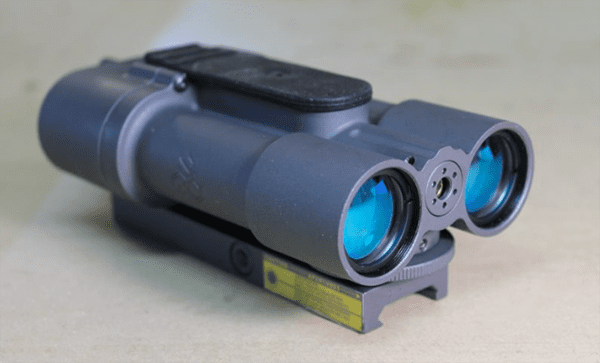
It should be obvious that to accurately hit something with a bullet at any distance that can be categorized as “long range”, you need to know how far away it is. It sure helps, anyway. There are a multitude of ways to do that, from the optical to the electronic.
A tried and true method, and one favored by pretty much every long distance shooter, is to bounce a laser off the thing you want to hit, let the device do some math to figure out how far away it is, and start shooting. The issue with that is it requires one more piece of gear to lug along on a trip (which may be lost or forgotten). SilencerCo would really like to convince you that mounting the Radius to your rifle is the solution to that problem.
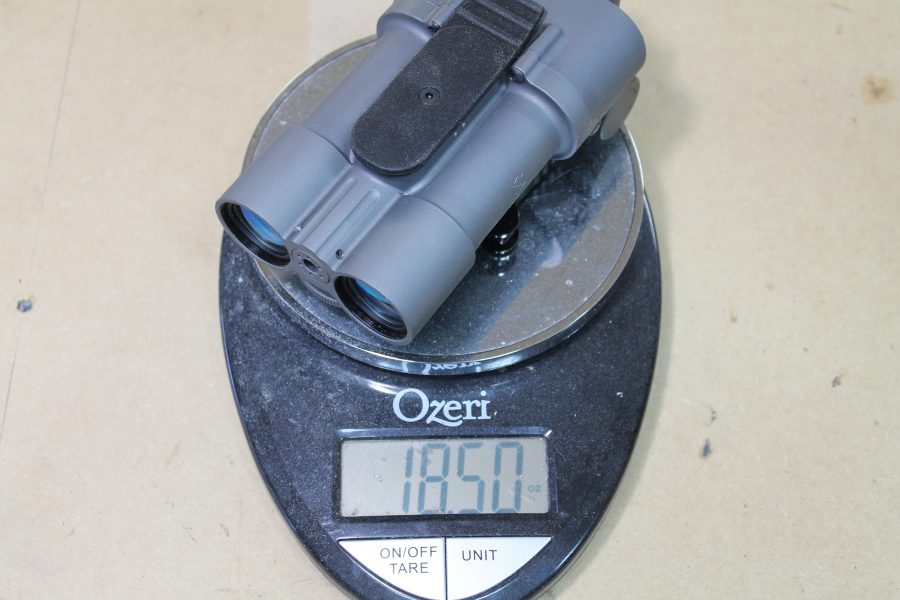
Before I get into the finer points of how that all works in the field, it might be worthwhile to look at SilencerCo, their new SWR brand, and the players involved in this project.
As you probably know, SilencerCo is an innovative Utah-based silencer manufacturer. Looking through their website and promotional material, if nothing else, you should be struck by the fact that SilencerCo is paying all the right marketing people to make their products look really, really good. Dig deeper, and you can see that they’re serious about their products. Love ’em or hate ’em, they offer a multitude of silencers to fit virtually every budget, need, and gun (including shotguns).
The Radius is actually marketed under their new SWR banner which now stands for SilencerCo Weapons Research and is positioned as the R&D/cool gadget side of operation. I say now as keen-eyed readers might remember that three-letter name used to apply to Southeastern Weaponry Research which was started by Henry Graham and which SilencerCo acquired back in 2011.
A year ago, with Graham gone, SilencerCo relaunched the SWR brand under the new SilencerCo Weapons Research moniker. Soon after, they debuted the Radius. More on tech specs in a bit, but put simply, the Radius is a weapon-attached laser rangefinder. With former TrackingPoint CEO Jason Schauble joining SilencerCo in January 2014 to head up sales, it should come as no surprise that the idea of sticking a laser rangefinder on a rifle was a natural extension.
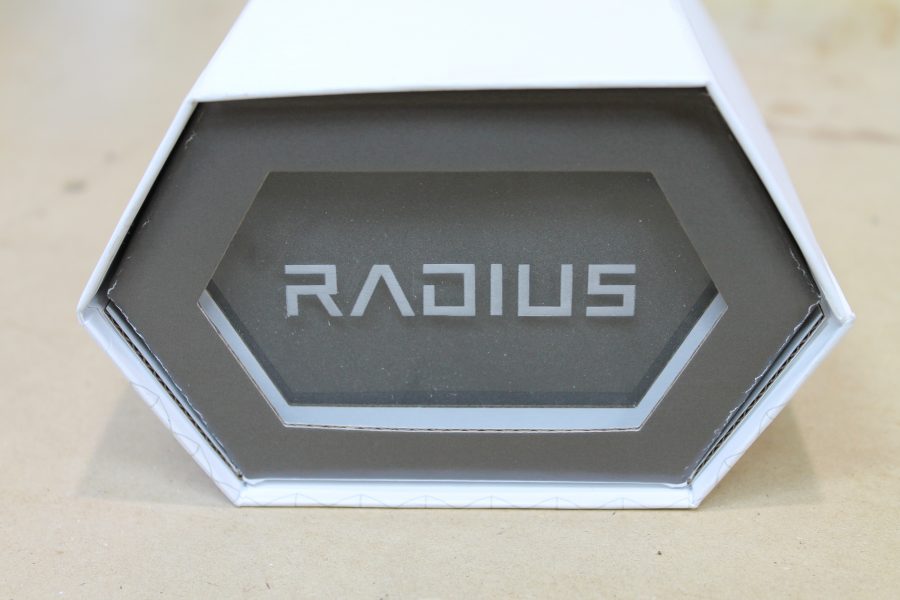
Unboxing the Radius at approximately the same time I started binge watching Silicon Valley, I couldn’t help but think of what must have been the endless meetings about the shape, style, and design of the box that the Radius ships in. It’s a seriously fancy way to store a piece of gear and goes far beyond the typical cardboard container most gear arrives in.
My second thought was, “damn this is heavy.” At a couple tenths over a pound, it’s a seriously heavy hunk of metal to plop on top (or the side) of your rifle. Where a laser designator can certainly add some bulk to your modern sporting rifle, it’s at least centered along the bore and maintains a reasonably low center of gravity. As the Radius needs to be mounted with a clear line of sight in both directions (towards you and the target), it can only be mounted along the side or atop a scope. Picatinny is the attachment method of choice.
I used the Radius on two different rifles during testing; Bergara’s LRP Elite and my home-built AR-15. In both cases, I elected to mount the Radius along the left side rail so I could peek at the display screen with my left eye while sighting through the scope using my right. Should you choose to mount it on top your scope, you’ll need a pretty tall Picatinny-topped scope ring.
I attempted to use Burris’ P.E.P.R mount, but found I didn’t have enough clearance for the objective I was using. As I didn’t have one of Nightforce’s RARs at the time, I ziptied the Radius in place at one point to see how it all looked, and found it adds a substantial amount of weight above the bore. Cant the rifle a bit, and it takes some oomph to get it righted.
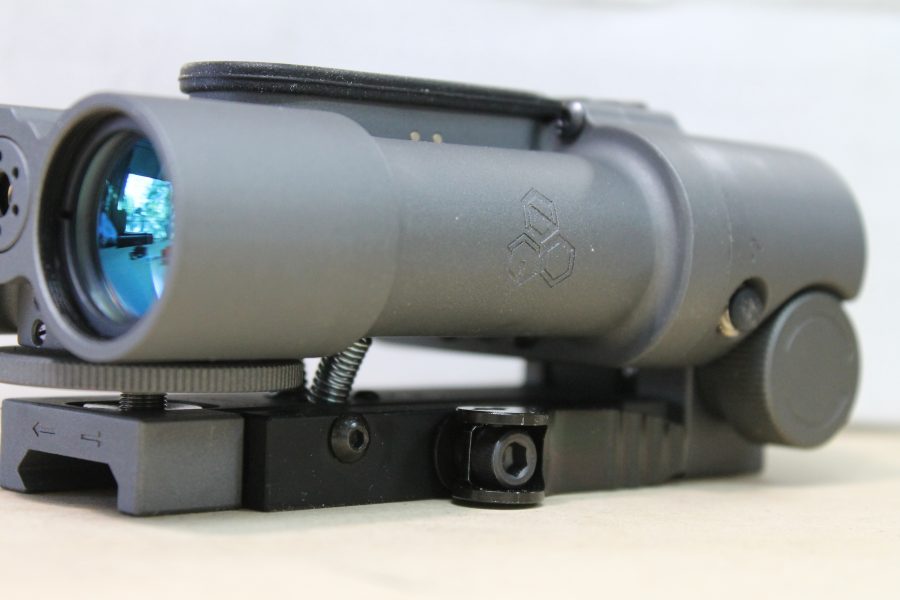
Once you’ve picked the ideal location, the Radius locks down using a QD lever that can be adjusted for tension using the hex screw seen above. Once mounted, the unit seems fairly secure, and the lever is low profile enough so as not to be inadvertently snagged on clothing or detritus in the wild.
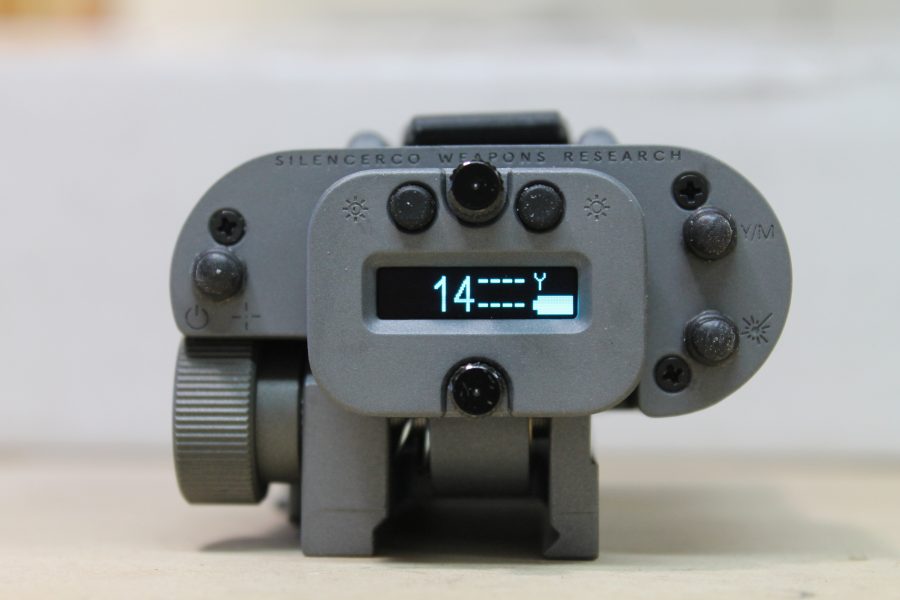
The next step is to orient the screen to your particular view by unscrewing the two black knobs at 12:00 and 6:00, pulling the screen off the main body, and orienting it correctly. Once it looks right, screw the knobs back down and pack your gear to head to the range. It’s time to align the Radius to your scope. I’ll let SWR’s marketing department take it from here.
In practice, the alignment procedure goes about like it does in the video. Keep in mind that each time the Radius is removed, it needs to be re-zeroed. If you get tired of hanging a pound of gear off your rifle, too bad.
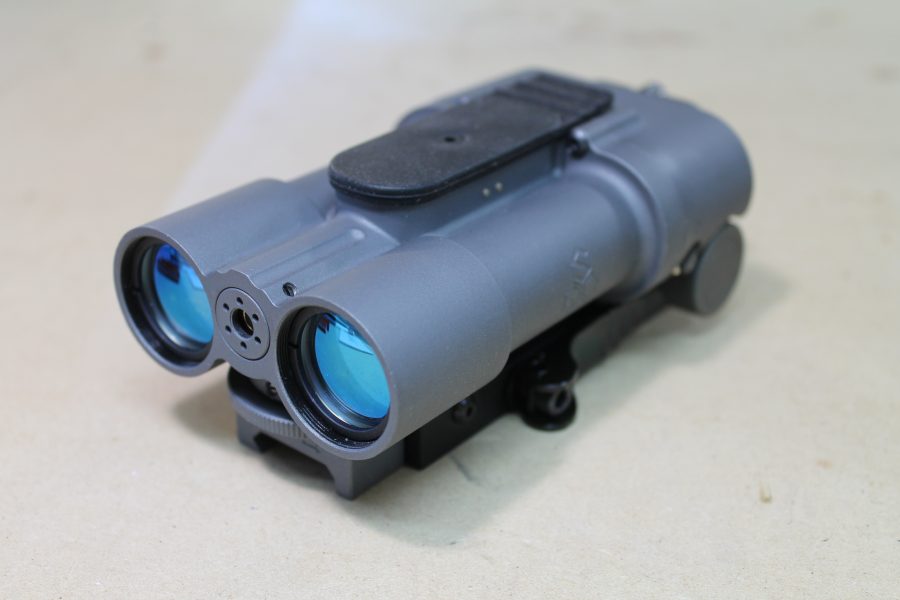
My first outing with the Radius was to a private shooting range with Torrey from Capitol Armory to test some Dead Air Silencers. In that review, you might notice references to the rain. It got pretty nasty there for a bit, but I took it as an opportunity to see how hardy the Radius was. As it turns out, it wasn’t.
After the rains cleared, I got behind the rifle only to find that the Radius’s display was on the fritz. It wasn’t completely dead, but it was throwing up gibberish and scrambled pixels on the screen. I emailed my point of contact at SilencerCo to tell him about the problem as we were heading home that afternoon, and within one hour, my phone was buzzing with a call from a VP of product development based in nearby Georgetown, Texas.
He apologized profusely and offered to drive a new unit to my house that night. Given that I wasn’t planning any shooting for a few more weeks, I politely declined, but told him whenever they could get me a replacement, I’d be game. He got my daytime address and at 10:00 the next morning, security in my building buzzed me to let me know that a courier was waiting in the lobby with a package for me. I turned over the old one and got a newer, more waterproof version in return.

The same VP called me later that afternoon to let me know that the display unit had a compromised seal, and that the unit itself was still fine, but that the display had died. More apologies came my way, more assurances of “shit happens” went his. We talked about the mounting system a bit and hung up.
My next call was to Torrey who’s a SilencerCo dealer. I was curious about how out of character this reaction was. He indicated that any of the customer service issues they’ve had with SilencerCo products have been dealt with promptly, usually with overnight shipping, and same week turnarounds. While he’s never seen them courier a replacement product to a customer, he did say that he wasn’t surprised with their reaction. Further water testing on my part yielded no more problems.

After shooting with the Radius for a half dozen more sessions, I have three major criticisms; technical, practical, and philosophical. I mentioned that I discussed the mounting system with the VP of product development. My question, though I wish I’d been more eloquent, boiled down to, “Why isn’t the visible laser always where I put it?”
Because the Radius uses a threaded screw system to handle the adjustments of a fairly large and heavy body, there’s some play in the mechanism. Set up at 100 yards and I could get the visible laser used for sighting dead on as in the video. But then if I’d torque the body or hit it lightly, it would return to a different point, sometimes an inch or more off my original point of aim.
When I brought this up with the aforementioned VP, he indicated that what I was seeing was normal and that shooting the gun should return it to the same point. Unfortunately, that wasn’t what I found. Recoil or not, the visible was like my keys — I would rarely find it where I thought I’d left it. That inch of deviation doesn’t sound like much, but it’s about a minute of angle at that distance which translates to something approaching eighteen inches at the one mile mark that SWR claims the Radius works at.
Sidenote:I got the Radius to range out to about 1200 yards on reflective steel targets, and that was the limit of what I could reliably range. Non-reflective objects like horses needed to be much closer for the Radius to work.
That leads to my practical criticism. When I stare through the lens of a handheld laser rangefinder, I can be reasonably assured that the thing I’m pointing the laser at is the thing that’s getting a laser bouncing off it. As the Radius needs to be co-witnessed with your rifle’s optic, there’s not the level of precision between optic and laser that you’d get with a handheld unit.
Where this rears its practical little head is ranging objects in anything but flatland. My range at the ranch has a pretty nice sized berm and from my favorite shade tree, a distance I know to be 485 yards. For the purposes of testing the Radius, I placed an IPSC torso-sized steel target about 10 yards forward of the berm and headed back to my tree. Using Bushnell’s Elite 1 Mile ConX, I centered the torso, hit the range button, and got my range…475 yards.
Using the Radius, I centered my scope’s crosshairs on the torso, hit the range button and got my range…485 yards. I walked the crosshairs around with the Radius in constant ranging mode, and eventually got it to register 475 yards.
I’ll be the first to admit that 10 yards of difference at 475 yards doesn’t make much difference. Using cheap, slow, 55 grain pills in my AR, that’s .2 mils which works out to be about three inches. That’s still acceptable (barely) for a vital zone hit on a whitetail-sized animal. It’s likely a miss on something like a prairie dog. Shooting flatter, faster bullets, ten yards of error really starts to become insignificant.
But what if you’re off by fifty yards at a distance that does start to matter, even for the slicker little pills? Practically speaking, that’s the difference between a hit or a miss. The Radius really only has to return incorrect data once to shatter my confidence in the system. That’s why I never took a shot based solely off the Radius’ reading, preferring to always back it with a handheld laser rangefinder or against a known distance.
My last criticism, and one that should maintain my status as King of the Fudds, is philosophical. Since the day I picked up a gun for the first time, I’ve been beaten over the head time and time again to never point my rifle at something I wasn’t willing to destroy. It’s why we teach young hunters to use binoculars instead of their rifle scope to look at animals downrange. It might be outdated and not very high speed, low drag, but the abstinence only model of gun safety works pretty well. If you don’t point your gun at something, you can’t shoot it it.
The Radius flat out breaks this axiom. To range a target, living or not, you have to point your rifle at it, and that’s something I have a philosophical problem with.

At the end of the day, the current incarnation of the Radius is a solution in search of a problem that’s already been solved. If it were smaller, more rugged, or less expensive, I’d be forced to reevaluate, but at $1000, you can go out and buy a really nice handheld and use the leftover cash for a ballistic app with a weather station that plugs into your smartphone. And a couple boxes of your favorite match ammo.
Specifications: SWR Radius Rangefinder
- Weight: 18.5 oz
- Ranging Distance: 1760 yards, advertised – 1200 yards, actual
- Attachment: Picatinny rail
- Warranty: Lifetime
- MSRP: $999, street price $950
Ratings (out of five stars):
Fit, Finish, Build Quality * * * *
The first unit I received fell victim to a little light rain. The problem was corrected quickly with a replacement unit and I had no further issues. Other that that issue, I was pleased at the level of fit and finish. All the surfaces are nicely rounded, the coatings are applied evenly, and the buttons and switches work well.
Function/Accuracy * * *
I have no doubt that whatever it’s pointing at is getting a laser bounced out and back, and that the reading on the screen is correct. That said, my experience was that getting reliable range data in hilly terrain or with backstops behind the target could lead to some uncertainty. Unless you scan around with it a bit, you really can’t be 100% certain in the value. Yes, I used it to put rounds on steel, but I have a much higher degree of confidence in a handheld unit.
Usability * *
It calculates straightline distance but not inclination. Longer shots and extreme uphill/downhill shots require that last piece of information. Not oft mentioned in the promo material is that you need to have your scope set at the 100 yard zero to co-witness the Radius. If you happened to have your scope set for a 600 yard shot, and saw a big bull elk at an unknown distance beyond that, you’d have to run the turret back to zero, range it, and then run the turret back to your new correction. That’s not a show stopper, but it’s the sort of thing an excited hunter might forget when staring at the trophy of a lifetime. And it’s just the sort of thing that could mean the difference between a hit and a miss.
Ergonomics * * *
It’s a one-pound brick that you strap to your rifle. Moved fairly far back on the handguard, it’s noticeable, but not life altering. Strapped to the top of a scope, it’s enough to mess with the balance of your rifle off a bag or bipod. Other than that, the buttons are in the right places and work well. There’s a provision to run a remote switch as well so you don’t have to move your hands and upset your rifle’s position. I like the idea, but the switch ended up looking pretty cheap on Bergara’s fancy rifle.
Overall Rating * *
After testing the Radius, I felt the same way I did leaving the TrackingPoint demo four years ago. I saw the potential, but I didn’t get the point then, and I don’t get the point now. Handheld laser rangefinders on the market today are more accurate at longer ranges, less expensive, more functional, lighter, and inspire more confidence in me as a shooter. I hate to hand the Radius two stars given what I think it represents and how gracious the SilencerCo team has been, but this product just isn’t there yet.




For that price it should come with a scope that uses the info and sights the scope in for me.
Burris eliminator 3.
Videos of that thing make it look pretty cool.
I’m actually surprised no other company made a scope with rangefinder, ballistics calculator and wireless connection to Kestrel… To me, it would make complete sense and would be the next generation of scopes.
Most excellent write-up. Learned a lot about the Radius and its use!
If you don’t want to point your rifle at something you aren’t willing to shoot, you could just not range it, no? I can’t help but think range finder integration into scopes is going to happen more and more often. Hopefully often enough that they lighten up and I can afford one.
When hunting, I often draw up a range card for the area I am observing. I pay special attention to animals I see. For instance, I may range a small herd of ewes I see, 500 yards away, in the hopes that a ram will be following them later. As they will almost certainly be grazing and moving, I may not have much time to range them and make adjustments when that double curl shows up.
Thanks. I am quite unaware of how to hunt. I have only shot prairie dogs before and I didn’t mind pointing the gun at any of them. I didn’t much enjoy it though.
“my experience was that getting reliable range data in hilly terrain or with backstops behind the target could lead to some uncertainty.”
It needs a “first return/last return” setting, so that you can select whether it ranges to the nearer object or the farther one.
If the elk is walking on the forward slope of the hill (in front of the crest) = first return. If it is walking on the reverse slope of the hill (or partially obscured by brush, etc) = last return.
At that price, I’d consider one of the electronic range finding scopes before buying this. Besides, where I hunt, it is rare to have a shot over 50 yards, and almost unheard of for one over 100 yards/
Not wanting to point my rifle at things all day while hunting, I’ll stick to my bushnell 1 mile arc binos. I need binos to hunt, and I need a range finder.
Bushnell has done a fine job of marrying the two.
And, it’s the same price as this…
True that, once you hunt with a decent (or even average) set of binoculars, using a rifle for sighting and spotting seems a lot more tedious. I try to do most of my ranging when there are no animals around to build a map in my head of each tree, shrub, or other distinctive landmark around so that when a target comes into the field I have a rough idea of “how far” everything is and can focus on determining age approximate size etc.
Build it into a scope, and get it so the laser is always aligned to the cross hairs.
There are versions of that available, but the next step will be reducing size and weight and connecting to a smart phone app for ballistics and weather/location data. Scan with the scope and see range displayed on the image, then click a button to designate your target and the holdover for your ballistics profile illuminates as the new point of aim. It could even account for wind hold if the app syncs with a kestrel or other wind meter unit or you could input average cross wind info in manually, etc.
Yeah that scope exists, to some extent, its called an ATN Thor HD. Though its only thermal sighted, I love its integrated range finder, and it has all the ballistic calculations built into the scope, with added wind from a kestrel, it adjusts the reticles on the fly. No, its not day time compatible really, at least not in the hot bright sun; but its a step in the right direction technology wise.
At the same price as my S&B PMII 5-25, for what it can do, its a decent upgrade for night time activity. Way better than the Radius it seems… At least for the night.
Very well written. Most people probably never considered some of the critical things that you pointed out. Would hate to spend a grand and be disappointed.
Thanks
Scrolled past this sizeable write-up to see the price… this product is not for me, possibly for someone with less patience than money. That’s just TheTruthAboutSomeThings, they’re too darn expensive.
Good write up, and I agree with all the criticisms. We do not need more things to add weight to our rifles, and we certainly don’t need those things to encourage us to point our rifle at targets we are not certain of.
I just grabbed one for $450, as it seems as though they are closing them out. I have yet to use it, but seems like a pretty interesting piece for less than half of the MSRP. I’ll give it a go.
I’ve been extremely pleased with mine. I got it on sale for around $400. Was it worth it-you bet. Oh no, not an extra pound! Sounds like you need to start carrying something lighter-like a tampon.
There’s no such thing as the “perfect scope”. But I keep lookin
I agree with your comment about the weight. I’ve never even noticed it. Last season I picked one up and used it on a bull Elk hunt. Really made a difference as I did not have to switch between my range finder binoculars and rifle. As far as this review is concerned I have to completely disagree with the majority of it. If you’re “rangefinding” a human in the first place I’m assuming you have plans to terminate the threat? I don’t know about you but when I point my rifle at a 4 legged critter I definitely intend on “putting it down”. That’s not even an argument. As far as the angle of the shot it sounds like you need to do your homework and learn how to use a cosign and quick reference ballistic tables. I’ve got a couple highly recommended classes I could refer you to to learn how to effectively use your rifle. The Radius definitely does what it was intended to do. After reading all these comments I can safely say the majority are the rantings of people that want “something for nothing”. How rare is that now a days? The Radius definitely has its place in my collection of accessories.
I started on COPD Herbal treatment from Ultimate Life Clinic, the treatment worked incredibly for my lungs condition. I used the herbal treatment for almost 4 months, it reversed my COPD. My severe shortness of breath, dry cough, chest tightness gradually disappeared. Reach Ultimate Life Clinic via their website at http://www.ultimatelifeclinic.com . I can breathe much better and It feels comfortable!
Comments are closed.